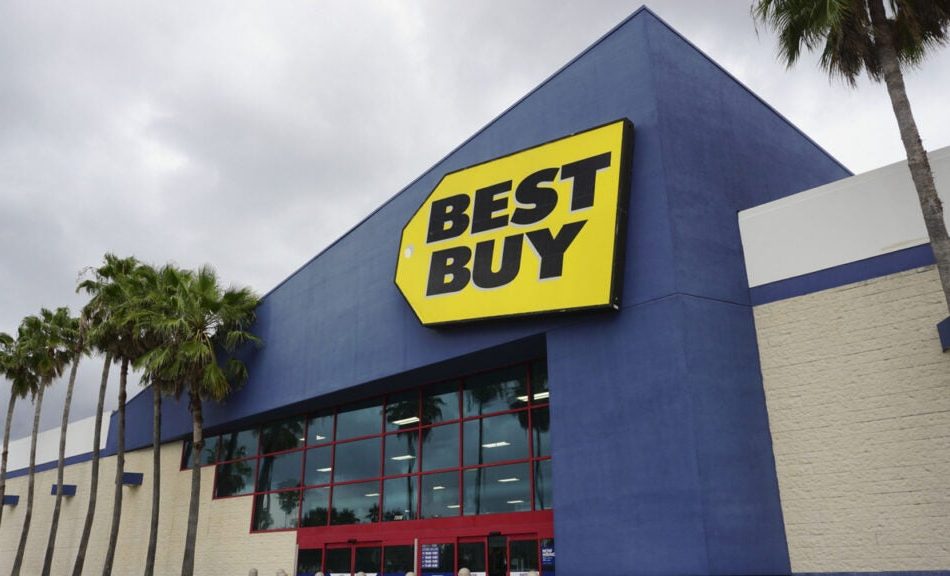Best Buy Says Q3 Sales 'Little Softer Than Expected' On Lower Demand For Appliances And Gaming, Trims Annual Forecast
On Tuesday, Best Buy Co., Inc BBY reported fiscal 2025 third-quarter adjusted EPS of $1.26, missing the consensus of $1.29.
Enterprise comparable sales fell 2.9%. Quarterly sales decreased to $9.45 billion from $9.76 billion a year ago, missing the analyst consensus of $9.63 billion.
Domestic revenue of $8.70 billion decreased 3.3% compared to last year, primarily due to a comparable sales decline of 2.8%.
From a merchandising perspective, the largest drivers of the comparable sales decline on a weighted basis were appliances, home theater, and gaming, partially offset by growth in the computing, tablets, and services categories.
Domestic online revenue of $2.73 billion decreased 1.0% on a comparable basis, and as a percentage of total Domestic revenue, online revenue was 31.4% versus 30.6% last year.
Also Read: Apple’s 2024 Black Friday Deals: Gift Cards Over Discounts — Here’s What You’ll Get
“In the third quarter, our teams delivered an in-line non-GAAP operating income rate on sales that were a little softer than expected,” said Corie Barry, Best Buy CEO.
“During the second half of the quarter, a combination of the ongoing macro uncertainty, customers waiting for deals and sales events, and distraction during the run-up to the election, particularly in non-essential categories, led to softer-than-expected demand. In the first few weeks of Q4, as holiday sales have begun and the election is behind us, we have seen customer demand increase again.”
International revenue of $748 million decreased by 1.6%, driven by a comparable sales decline of 3.7% and the negative impact of foreign exchange rates, partially offset by revenue from Best Buy Express locations opened in Canada during FY25.
Outlook: Best Buy trimmed its fiscal year 2025 revenue outlook from $41.3 billion – $41.9 billion to $41.1 billion – $41.5 billion compared to the consensus of $41.59 billion.
The company revised the adjusted EPS outlook from $6.10 – $6.35 to $6.10 – $6.25, compared to the consensus of $6.25.
Comparable sales are expected to decline between 3.5% and 2.5%, compared to prior guidance for a decline between 3.0% and 1.5%.
Best Buy expects fourth-quarter comparable sales to be flat to down 3% and an adjusted operating income rate of 4.6% – 4.8%
Price Action: BBY stock is down 7.23% at $86.30 during the premarket session at last check Tuesday.
Also Read:
Image via Shutterstock.
Market News and Data brought to you by Benzinga APIs
© 2024 Benzinga.com. Benzinga does not provide investment advice. All rights reserved.
Top 3 Industrials Stocks You May Want To Dump This Quarter
As of Nov. 26, 2024, three stocks in the industrials sector could be flashing a real warning to investors who value momentum as a key criteria in their trading decisions.
The RSI is a momentum indicator, which compares a stock’s strength on days when prices go up to its strength on days when prices go down. When compared to a stock’s price action, it can give traders a better sense of how a stock may perform in the short term. An asset is typically considered overbought when the RSI is above 70, according to Benzinga Pro.
Here’s the latest list of major overbought players in this sector.
Woodward, Inc. WWD
- On Nov. 25, Woodward reported better-than-expected quarterly EPS and sales. “We delivered record sales in fiscal 2024 with Woodward revenue exceeding $3 billion for the first time. Robust end market demand along with contributions from operational excellence fueled significant sales growth and earnings expansion,” said Chip Blankenship, Chairman and Chief Executive Officer. The company’s stock gained around 5% over the past five days and has a 52-week high of $188.34.
- RSI Value: 81.90
- WWD Price Action: Shares of Woodward gained 1.8% to close at $179.29 on Monday.
Aris Water Solutions Inc ARIS
- On Nov. 4, Aris Water Solutions reported better-than-expected third-quarter financial results. “Aris had an exceptional third quarter as we continued to grow our produced water volumes, increased our recycled water sales, and maintained our strong margins. As we anticipated, our capital investment to support these increased activity levels was primarily deployed in the first half of the year and our capital spending in the third quarter declined significantly. We continue to experience steady volume growth and increasing cash generation,” said Amanda Brock, President and CEO of Aris. The company’s stock gained around 79% over the past month and has a 52-week high of $27.64.
- RSI Value: 80.45
- ARIS Price Action: Shares of Aris Water Solutions gained 0.2% to close at $27.03 on Monday.
Mesa Air Group Inc MESA
- On Oct. 16, Mesa Air Group reported a year-over-year decrease in third-quarter revenue results. The company’s stock gained around 14% over the past five days and has a 52-week high of $1.89.
- RSI Value: 74.27
- MESA Price Action: Shares of Mesa Air gained 12.3% to close at $0.98 on Monday.
Read This Next:
Market News and Data brought to you by Benzinga APIs
© 2024 Benzinga.com. Benzinga does not provide investment advice. All rights reserved.
Vertex Holiday Shopping Survey Emphasizes the Crucial Role of Tax Automation
KING OF PRUSSIA, Pa., Nov. 26, 2024 (GLOBE NEWSWIRE) — Vertex Inc. VERX (“Vertex” or the “Company”), a global provider of tax technology solutions, announced the results of its peak season consumer survey, revealing how modern consumer behavior continues to challenge businesses for managing shifting expectations and shopping habits in a competitive retail landscape.
Today’s consumers expect to purchase any item from any retailer, anywhere, without additional costs—challenging businesses to streamline tax processes and manage indirect expenses seamlessly. These shopper preferences add further complexity during high-volume shopping periods. Out of 1,000 respondents, 73% are prioritizing free shipping and 58% are choosing to purchase more gift cards and experiences this season compared to previous years. This underscores the immediate need for retailers to implement fast and accurate tax calculations to ensure seamless transactions – for digital goods, gift cards or physical items at checkout.
“During major shopping events like Black Friday and Cyber Monday, retailers want the confidence of knowing their tax configuration and setup is already in place, and able to scale, so they do not need to touch their system in these critical peak periods,” said Sal Visca, Chief Technology Officer, Vertex. “This is a top priority for Vertex when supporting our customers on their biggest days – especially in the e-commerce era where they have buyers from all over the world shopping at any time during the day or night. Resiliency, elasticity and redundancy are foundational in our platform so there is no friction in the user journey or loss of commerce flow which could ultimately impact the bottom line.”
As businesses continue to meet these demands, omnichannel commerce adds significant tax complexity. Customers may purchase from one channel and return in another, often spanning across different taxing jurisdictions – among 13,000 in the U.S. Additionally, retailers introducing new products and bundles must classify them for accurate taxability and calculation. This demands comprehensive tax content that is up to date with the ever-changing monthly updates, configurable rules and automation tools to streamline the process, ensuring seamless handling of any product in any location. Vertex’s automated tax solutions can simplify this process, helping tax departments manage the complexity and helping to ensure compliance with every transaction.
Other findings from the survey include:
- Online retail traffic to surge: 77% of combined consumers plan to shop more online or a mix of online and in-store. With only 23% planning to purchase more items in-store, retailers will process a high volume of transactions across both channels – relying on their technology solutions to maintain consistency, system efficiency, reliability and stability during these peak moments.
- Consumers favor marketplaces: 64% opt to shop through a trusted marketplace, which likely offers free shipping, multi-vendor product and service bundling and convenience perks and simpler returns versus a retailer’s online shopping experience.
- Consumer behavior and sales tax knowledge: 72% of consumers closely track where a product ships from and 73% are aware of their home state’s sales tax. However, only 17% factor sales tax into their purchasing decisions or consider the complexities retailers face when selling in one state and shipping to another.
Retailers must capitalize on major shopping holidays, such as Black Friday and Cyber Monday, when consumer participation is at an all-time high. Accurate, fast and automated tax calculation is essential for providing a seamless customer experience, and a trusted tax engine is crucial for efficiently maintaining compliance. With Vertex’s end-to-end platform, retailers can capitalize on peak moments while ensuring continuous compliance.
To learn more about Vertex and its indirect tax and compliance solutions for e-commerce and more, visit www.vertexinc.com/solutions.
About the Survey
This survey was conducted via Dynata and polled 1,000 general U.S.-based consumers over 18 years of age in November 2024. Respondents were segmented and analyzed across age groups, gender, marital status, having children and household income. For complete survey methodology, please email vertex@pancomm.com.
About Vertex
Vertex, Inc. is a leading global provider of indirect tax solutions. The Company’s mission is to deliver the most trusted tax technology enabling global businesses to transact, comply and grow with confidence. Vertex provides solutions that can be tailored to specific industries for major lines of indirect tax, including sales and consumer use, value added and payroll. Headquartered in North America, and with offices in South America and Europe, Vertex employs over 1,500 professionals and serves companies across the globe.
For more information, visit www.vertexinc.com or follow us on Twitter and LinkedIn.
Copyright © 2024 Vertex, Inc. All rights reserved. The information contained herein is intended for information purposes only, may change at any time in the future, and is not legal or tax advice. The product direction and potential roadmap information is not a guarantee, may not be incorporated into any contract, and is not a commitment to deliver any material, code, or functionality. This information should not be relied upon in making purchasing, legal, or tax decisions. The development, release, and timing of any features or functionality described for Vertex’s products remains at the sole discretion of Vertex, Inc. Any statements in this release that are not historical facts are forward-looking statements as defined in the U.S. Private Securities Litigation Reform Act of 1995. All forward-looking statements are subject to various risks and uncertainties described in Vertex’s filings with the U.S. Securities and Exchange Commission (“SEC”) that could cause actual results to differ materially from expectations. Vertex cautions readers not to place undue reliance on these forward-looking statements which Vertex has no obligation to update.
Vertex Company Contact:
Rachel Litcofsky
Manager, Public Relations
mediainquiries@vertexinc.com

© 2024 Benzinga.com. Benzinga does not provide investment advice. All rights reserved.
Vacuum Cleaner Market is Predicted to Evolve at a Notable 9.7% CAGR through 2031 | SkyQuest Technology
Westford USA, Nov. 26, 2024 (GLOBE NEWSWIRE) — SkyQuest projects that the Vacuum Cleaner Market. size will attain a value of USD 29.45 Billion by 2031, with a CAGR of 9.7% over the forecast period (2024-2031). Growing disposable income of people around the world and rising emphasis on cleanliness and hygiene are projected to primarily augment the vacuum cleaner market growth over the coming years. The development of robotic and automated vacuum cleaners is projected to offer new business opportunities for market players going forward.
Download a detailed overview: https://www.skyquestt.com/sample-request/vacuum-cleaner-market
Browse in-depth TOC on “Vacuum Cleaner Market”
- Pages – 165
- Tables – 62
- Figures – 75
Vacuum Cleaner Market Overview:
| Report Coverage | Details |
| Market Revenue in 2023 | $ 12.8 Billion |
| Estimated Value by 2031 | $ 29.45 Billion |
| Growth Rate | Poised to grow at a CAGR of 9.7% |
| Forecast Period | 2024–2031 |
| Forecast Units | Value (USD Billion) |
| Report Coverage | Revenue Forecast, Competitive Landscape, Growth Factors, and Trends |
| Segments Covered | Application, Distribution Channel, and Region |
| Geographies Covered | North America, Europe, Asia-Pacific, Latin America, and Middle East and Africa |
| Report Highlights | Growing disposable income slated to boost sales of vacuum cleaners |
| Key Market Opportunities | Development of smart and automated vacuum cleaners |
| Key Market Drivers | Rising emphasis on cleanliness and hygiene around the world |
Demand for Vacuum Cleaners in Residential Applications is Slated to Hold Dominant Share
Growing emphasis on cleanliness and rising disposable income of people have led to high demand for vacuum cleaners in homes around the world. Rising affordability of vacuum cleaners and evolving consumer preferences are also expected to play a vital role in promoting the high market share of this segment going forward. High demand for home automation is also expected to bolster vacuum cleaner market outlook in residential applications.
Online Channels are Estimated to Boost Sales of Vacuum Cleaners in Long Run
Increasing preference of people to shop online and growing internet proliferation are slated to be key factors allowing online channels to emerge as a highly opportune segment. High availability of discounts and a booming e-commerce industry are also expected to play a pivotal role in making this the fastest expanding distribution channel for vacuum cleaner companies in the future.
Rising Disposable Income Allows Asia-Pacific to Emerge as the Leading Market for Vacuum Cleaners
The presence of multiple vacuum cleaner providers coupled with growing disposable income has allowed Asia Pacific to account for a major chunk of the global vacuum cleaner market share. China, Japan, and India are slated to be highly remunerative countries for vacuum cleaner suppliers across the study period and beyond. Changing consumer preferences and growing technological proliferation are also forecasted to help this region’s dominance in the long run.
Request Free Customization of this report: https://www.skyquestt.com/speak-with-analyst/vacuum-cleaner-market
Vacuum Cleaner Market Insights:
Drivers
- Growing emphasis on cleanliness and hygiene
- Rising disposable income and evolving consumer preferences
- Increase in the use of smart home devices and automation
Restraints
- High maintenance costs
- High saturation of vacuum cleaner providers in developed countries
Prominent Players in Vacuum Cleaner Market
- Dyson Ltd.
- AB Electrolux
- Miele & Cie. KG
- LG Electronics Inc.
- Samsung Electronics Co. Ltd.
- Panasonic Corporation
- iRobot Corporation
- SharkNinja Operating LLC
- Bissell Inc.
- TTI Floor Care North America
View report summary and Table of Contents (TOC): https://www.skyquestt.com/report/vacuum-cleaner-market
Key Questions Answered in Vacuum Cleaner Market Report
- Which key drivers for vacuum cleaner providers are highlighted in this market forecast?
- Who is the leading vacuum cleaner company in the world?
- Which region brings in the most revenue as per this vacuum cleaner market analysis?
- Which key market trends are slated to boost revenue generation for vacuum cleaner providers through 2031?
This report provides the following insights:
- Analysis of key drivers (growing disposable income, rising awareness regarding cleanliness and hygiene, high use of smart home devices and automation), restraints (high costs of maintenance, high saturation in developed countries), and opportunities (development of smart and automated vacuum cleaners) influencing the growth of vacuum cleaner market.
- Market Penetration: All-inclusive analysis of product portfolio of different market players and status of new product launches.
- Product Development/Innovation: Elaborate assessment of R&D activities, new product development, and upcoming trends of the vacuum cleaner market.
- Market Development: Detailed analysis of potential regions where the market has potential to grow.
- Market Diversification: Comprehensive assessment of new product launches, recent developments, and emerging regional markets.
- Competitive Landscape: Detailed analysis of growth strategies, revenue analysis, and product innovation by new and established market players.
Related Reports:
Data Center Market
Quantum Computing Market
Display Market
Sensor Market
E-Commerce Market
About Us:
SkyQuest is an IP focused Research and Investment Bank and Accelerator of Technology and assets. We provide access to technologies, markets and finance across sectors viz. Life Sciences, CleanTech, AgriTech, NanoTech and Information & Communication Technology.
We work closely with innovators, inventors, innovation seekers, entrepreneurs, companies and investors alike in leveraging external sources of R&D. Moreover, we help them in optimizing the economic potential of their intellectual assets. Our experiences with innovation management and commercialization have expanded our reach across North America, Europe, ASEAN and Asia-Pacific.
Contact:
Mr. Jagraj Singh
Skyquest Technology
1 Apache Way,
Westford,
Massachusetts 01886
USA (+1) 351-333-4748
Email: sales@skyquestt.com
Visit Our Website: https://www.skyquestt.com/

Market News and Data brought to you by Benzinga APIs
© 2024 Benzinga.com. Benzinga does not provide investment advice. All rights reserved.
'The Days Of Free Money Are Over': 2025 Real Estate Predictions From CRE's Top Ten Issues Report
Perhaps obviously, the real estate industry is facing an uphill challenge heading into 2025, with global elections, financing costs and mounting debt maturities being the most pressing concerns, according to the Counselors of Real Estate’s (CRE) annual Top Ten Issues report.
Don’t Miss:
The report points to an industry grappling with unprecedented uncertainty. At the front is an estimated $2.5 trillion in commercial loan debt set to mature by 2026, forcing a reckoning in property valuations and financing structures.
“Whether the Fed reduces rates four times or two or three or five, rates are not going down to zero,” Anthony DellaPelle, CRE’s 2024 global chair, said at a conference last week. “I don’t think you’ll see people get mortgages under 3% for a long, long time unless something weird happens and I don’t wish that upon us.”
The rising cost of property insurance adds another layer of uncertainty to the market. Insurance companies, facing increased risk from extreme weather events and property damage, have continued to raise premiums. The trend directly impacts property values and transaction feasibility across all sectors.
Trending: This Jeff Bezos-backed startup will allow you to become a landlord in just 10 minutes, with minimum investments as low as $100 for properties like the Byer House from Stranger Things.
The CRE said office vacancies are a thorny issue, with ripple effects extending beyond commercial real estate. According to HousingWire, DellaPelle cited a recent transaction in which a $32 million assessed office building sold for just $8.5 million, marking the value reset occurring in many markets.
Those devaluations threaten local tax bases and could force municipalities to shift tax burdens onto residential property owners. The housing market faces its own set of challenges, particularly around affordability and inventory constraints.
Demographics play a role, according to the report, with many older homeowners choosing to stay put rather than trade up at higher interest rates. “Why would I sell my house and buy a new one, taking on a 7% mortgage to get a smaller house that is going to end up costing me more than my big house?” DellaPelle said.
See Also: Commercial real estate has historically outperformed the stock market, and this platform allows individuals to invest in commercial real estate with as little as $5,000 offering a 12% target yield with a bonus 1% return boost today!
Sustainability concerns continue to gain prominence, driven by regulatory changes and shifting consumer preferences. Property owners face mounting pressure to understand and reduce their carbon footprints, while younger buyers increasingly prioritize climate resilience in their purchasing decisions.
The geopolitical landscape adds another layer. Global conflicts and political shifts can quickly impact supply chains, construction costs and investment patterns. The report highlights how international tensions often drive foreign capital into U.S. real estate markets as investors seek safe havens.
The report suggests that success in this challenging environment requires careful attention to demographic trends and population movements. “You have to anticipate where they [people] are going,” DellaPelle said.
Read Next:
Market News and Data brought to you by Benzinga APIs
© 2024 Benzinga.com. Benzinga does not provide investment advice. All rights reserved.
Market Digest: GOLD, ALL, CHD, LHX, HST, AZN, DOW
Summary
Corporate insiders appear content to run out the clock on 2024. With all the recent volatility (election results, interest-rate confusion, earnings season, and geopolitical issues), current insider-sentiment indicators from Vickers Stock Research sit squarely in the neutral camp. By way of detail, the neutral range for Vickers’ sell/buy ratios runs from 2.00 up to 6.00. This week, the major one-week ratios are 4.19 (the Total, or all-exchanges ratio); 4.76 (for the NYSE); and 4.04 (for the Nasdaq). ‘Neither a buyer nor a seller be’ it would seem. One indicator does jump out this week and is forward looking. The number of Form 144s processed month-to-date by Vickers is 3197. This form is used by insiders to indicate an intent to sell restricted or control shares. The average full-month number of 144s processed by Vickers over the past six months is 2153 — so a current reading of 3197 with another week to go in November is worth watching. The full-month number in November 2023 was 2460. On a sector basi
3 Brilliant Growth Stocks to Buy Now and Hold for the Long Term
Growth stocks can give you the best bang for your buck when it comes to growing your wealth to better prepare for retirement. Such companies can steadily grow their earnings and cash flows, garnering them higher share prices over time. This means that the value of your investment portfolio will also climb up in tandem.
The key is to hold such stocks for the long term as time works its magic on high-quality businesses. Selling them in a rush just to lock in short-term profits would unnecessarily disrupt this process of wealth-building.
Start Your Mornings Smarter! Wake up with Breakfast news in your inbox every market day. Sign Up For Free »
There are certain attributes that are particularly worth looking for when you’re trying to select a stock you’ll feel good about keeping in your portfolio for many years. The business should boast a strong competitive edge that will help it fend off competition, have a long track record of growing its revenue and net income, and generate copious amounts of free cash flow so it won’t have to rely on the kindness of banks or the bond market.
These ingredients won’t just provide you with greater peace of mind along your investing journey, they’re also crucial in helping you to compound your wealth. The three attractive growth stocks possess those attributes. You might wish to add any or all of them to your portfolio to hold for the long term.
Intercontinental Exchange (NYSE: ICE) is a provider of data services and technology solutions for mortgages, equities, futures, and fixed-income securities. The company serves a wide range of customers such as financial institutions, corporations, and government bodies.
The Atlanta-based company has made steady strides in growing its revenue and profits. Its revenue increased from $7.1 billion in 2021 to $8 billion in 2023 while operating income improved from $3.4 billion to $3.7 billion over the same period. Net income (after adjusting for exceptional items) jumped from $1.6 billion to $2.5 billion. Intercontinental Exchange’s free cash flow also increased from $2.7 billion in 2021 to $3.1 billion in 2023.
The business saw continued growth in the first nine months of this year. Revenue climbed 20.2% year over year to $7 billion while operating income rose 16.7% to $3.2 billion. Net income, however, edged up just 3.1% because of higher tax expenses. Even so, free-cash-flow generation stayed strong, coming in at $2.6 billion versus $2.2 billion in the prior-year period, up nearly 17%. Those results allowed management to increase the company’s quarterly dividend by 7% to $0.45 per share.
H World Group Limited Announces the Third Quarter 2024 Financial Results
Strong Brands Drive Growth, Balancing Scale and Quality, Global Expansion Reaches New Heights
HONG KONG, Nov. 26, 2024 /PRNewswire/ — H World Group Limited ((“, H World”, or “, the Group”, , NASDAQ:HTHT) announced its unaudited financial results for the third quarter of 2024 (“Q3 2024“), with both revenue and hotel turnover showing growth. According to the announcement, H World’s revenue increased 2.4% year-over-year to RMB6.4 billion in the third quarter of 2024. Among this, revenue from H World’s business in China (“Legacy-Huazhu” or “Huazhu”) increased 1.0% year-over-year; and revenue from H World International (“Legacy-DH” or “DH”) increased 8.9% year-over-year. Meanwhile, the Group’s hotel turnover increased 10.7% year-over-year to RMB26.0 billion. Hotel turnover from the Legacy-Huazhu segment increased 11.0% year-over-year; and hotel turnover from the Legacy-DH segment increased 7.8% year-over-year. The Group’s business scale further expanded both domestically and internationally.
H World was founded in 2005 and has since grown into one of the world’s leading hotel management groups. With outstanding product innovation and brand operations, H World has gradually established a leading position in the market and continues to drive the development of the hotel industry. As of the end of the third quarter, H World operated 10,845 hotels in 18 countries, with 2,925 unopened hotels in the pipeline.
Jin Hui, CEO of H World commented: “After reaching the milestone of 10,000 hotels in the second quarter, we continued our fast-paced, high-quality network growth and opened 774 new hotels in China in the third quarter of 2024. Our occupancy rate remained solid at 85% despite our ongoing rapid hotel network expansion. Going forward, we will continue to emphasize the importance of sustainable high-quality growth. We aim to expand our presence across all regions and continue penetrating into lower-tier cities in China, thereby reaching more of China’s hotel market with our high-quality hotel products with excellent services. Regarding our business outside China, We continued focusing on cost reduction in our European business, while at the same time seeking growth opportunities in the Asia-Pacific (APAC) and in the Middle East areas.”
Net Income Reaches RMB 1.3 Billion, Demonstrating Strong Market Competitiveness
In the third quarter of 2024, despite facing the challenge of an overall industry downturn, H World demonstrated its strong market competitiveness, with revenue reaching RMB6.4 billion, significantly exceeding the industry average (based on statistics from eight domestic and international peers that have released their Q3 2024 financial reports to date). Among this, Legacy-DH saw an 8.9% year-over-year growth, showing steady growth in the global market. Furthermore, amidst the general decline in industry net profits, H World achieved a net income attributable to H World of RMB1.3 billion, far surpassing the industry average, demonstrating strong profitability.
In terms of operating margin, H World’s operating margin reached 26.7%, an increase of 1.1 percentage points compared to the previous quarter, indicating a steady recovery. Notably, Legacy-Huazhu achieved an operating margin of 34.2%, a 3.2 percentage point increase quarter-over-quarter, further consolidating the Group’s leading position in the Chinese market.
Diverse Brand Portfolio Drives Robust Hotel Network Expansion
As a youthful group, H World, with its keen market insight into consumer trends and the hotel industry, as well as its product innovation capabilities, continuously nurtures outstanding proprietary brands. Products such as HanTing Hotel and JI Hotel are all self-developed by the group and occupy leading positions in their respective price segments, forming the core foundation of the group. At the same time, the Group has also continuously enriched its brand matrix through external partnerships and acquisitions. Currently, H World operates over 30 brands, covering all market segments, including Economy hotels, Midscale hotels, Upper midscale hotels, Upscale hotels, Luxury hotels and other market segments. This diverse brand portfolio not only expands the Group’s user base but also enables it to more accurately capture the needs of different franchisees and consumers, further enhancing its market competitiveness.
With its strong brand appeal, H World has attracted increasing attention from franchisees. Combined with the Group’s light-asset business model, it has been able to rapidly expand, focusing on both lower-tier markets and high-end growth. In the third quarter of 2024, Legacy-Huazhu successfully opened 774 new hotels in the Chinese market, a year-over-year increase of 42%, further accelerating the expansion of its hotel network. This pace of new openings is among the fastest in the hotel industry, fully demonstrating the Group’s powerful market expansion capabilities and brand influence.
In the third quarter, the share of hotels in third-tier and lower cities reached 42% of Legacy-Huazhu’s total operating hotels, an increase of 2 percentage points year-over-year. The Group continues to penetrate lower-tier markets, improving the long-standing lack of quality supply in these cities. Additionally, the Group has aligned with the mid-to-high-end development trend in the hotel industry, driven by an upgrade in consumer demand, and has seized the opportunity in the mid-to-high-end market with its expanding brand portfolio. Data shows that in the third quarter, the number of mid-to-high-end hotels operated by Legacy-Huazhu increased by 33% year-over-year to 803 hotels. By the end of the reporting period, the number of hotels under development increased by 36% year-over-year. Among them, H World’s upper midscale hotels brand, IntercityHotel, acquired overseas, has performed exceptionally well in China. Within five years, the number of operating and unopened hotels has reached 125.
In addition, with the increase in business activities, the demand for hotel services by business travelers is gradually recovering, and H World’s performance is expected to see new growth drivers. According to the 2023 Global Business Travel Index Annual Outlook Report published by the Global Business Travel Association (GBTA), global business travel spending is projected to reach $1.5 trillion in 2024, with China’s business travel expenditure expected to reach $370 billion, an 8.8% increase compared to 2023. Against this backdrop, H World is actively responding to changes in market demand. In September this year, the group’s upper midscale hotel brand, Crystal Orange Hotel, underwent an in-depth iteration and launched its latest version 2.5. This version introduces the concept of “pure sleep,” returning to the essence of business travel hotels and focusing on enhancing the core experience of “high-quality sleep” for business travelers.
Balancing “Quantity” and “Quality”: Significant Results from the High-Quality Development Strategy
As the consumer market returns to rationality, consumers have become more discerning, seeking better value for money while also raising their expectations for quality consumption. As a result, while H World continues to pursue store expansion and scale, it also strictly implements its high-quality development strategy.
According to the latest financial report, H World currently operates 10,845 hotels, with 10,707 of them located in China, placing it among the leaders in the industry in terms of the number of operating hotels. Despite such a high base of hotels, the group’s occupancy rates (“OCC“) remains at a relatively high level. In particular, Legacy-Huazhu’s OCC steadily increased in the first three quarters, with the third-quarter OCC reaching approximately 85%, which also exceeds the industry average. H World has maintained a high occupancy rate during its ongoing store expansion. This is attributed to the targeted optimization of its sales channels. Legacy-Huazhu has effectively strengthened the customer acquisition and sales capabilities of its stores, further emphasizing the importance of direct sales and membership for the company’s long-term sustainable development. Data shows that in the third quarter, the contribution of central reservations to Legacy-Huazhu’s room nights reached 64.2%, marking a year-on-year increase of 2.2 percentage points and a quarter-on-quarter increase of 4.3 percentage points. The number of members has approached 260 million.
Accelerating Global Expansion: Exciting Prospects Ahead
In 2019, H World announced the opening of the first overseas direct-operated hotel of its brand, “JI Hotel” in Singapore, marking the official launch of the Group’s overseas development strategy. In 2020, the Group expanded its international presence through the full acquisition of Deutsche Hospitality, using it as a “springboard” to explore additional market opportunities in other overseas regions. Going forward, H World will continue to actively explore international development and seek growth opportunities in the Asia-Pacific and Middle East regions, gradually advancing its globalization process. As of September 30, 2024, Legacy-DH operates 138 hotels, with 26 more in the pipeline. In the third quarter, Legacy-DH reported an average daily room rate (“ADR”) of €117, a 2.5% year-on-year increase; an OCC of 69.8%, up 0.8 percentage points year-on-year; and a revenue per available room (“RevPAR”) of €82, which increased by 3.7% year-on-year, demonstrating an overall improvement in operational efficiency.
In early November 2024, the Group made its debut at the China International Import Expo (“CIIE”), showcasing the innovative model of China’s hotel industry to the world. This also conveyed Huazhu’s confidence in the Chinese market, reflecting its commitment to the development strategy of “rooted in China, reaching the world.” H World’s CEO, Jin Hui, stated: “A world-class hotel group must ensure that its brand and management meet world-class standards. Today, China’s hotel industry has already developed some core competitive advantages, such as leading integration efficiency and technology application. H World is confident that through high-quality development, we will bring China’s hotel industry to world-class heights.”
-End-
About H World Group Limited
Originated in China, H World Group Limited is a key player in the global hotel industry. As of September 30, 2024, H World operated 10,845 hotels with 1,062,546 rooms in operation in 18 countries. H World’s brands include Hi Inn, Elan Hotel, HanTing Hotel, JI Hotel, Starway Hotel, Orange Hotel, Crystal Orange Hotel, Manxin Hotel, Madison Hotel, Joya Hotel, Blossom House, Ni Hao Hotel, CitiGO Hotel, Steigenberger Hotels & Resorts, MAXX, Jaz in the City, IntercityHotel, Zleep Hotels, Steigenberger Icon and Song Hotels. In addition, H World also has the rights as master franchisee for Mercure, Ibis and Ibis Styles, and co-development rights for Grand Mercure and Novotel, in the pan-China region.
H World’s business includes leased and owned, manachised and franchised models. Under the lease and ownership model, H World directly operates hotels typically located on leased or owned properties. Under the manachise model, H World manages manachised hotels through the on-site hotel managers that H World appoints, and H World collects fees from franchisees. Under the franchise model, H World provides training, reservations and support services to the franchised hotels, and collects fees from franchisees but does not appoint on-site hotel managers. H World applies a consistent standard and platform across all of its hotels. As of September 30, 2024, H World operated 9 percent of its hotel rooms under the lease and ownership model, and 91 percent under the manachise and franchise model.
For more information, please visit H World’s website: https://ir.hworld.com.
![]() View original content to download multimedia:https://www.prnewswire.com/news-releases/h-world-group-limited-announces-the-third-quarter-2024-financial-results-302316518.html
View original content to download multimedia:https://www.prnewswire.com/news-releases/h-world-group-limited-announces-the-third-quarter-2024-financial-results-302316518.html
SOURCE H World
© 2024 Benzinga.com. Benzinga does not provide investment advice. All rights reserved.
Daily Spotlight: Fed's Favorite Inflation Indicator
Summary
The Federal Reserve’s favorite inflation indicator, the PCE Price Index, will be released by the BEA tomorrow morning. The PCE Index differs from the better-known Consumer Price Index (CPI) because its composition is changed more frequently and it is thus quicker to reflect the impact of real-time pricing fluctuations. In the most recent report, through September, PCE inflation was reported at 2.1% year over year (by comparison, the latest CPI report, through October, had inflation at 2.6%). Core PCE, which removes volatile food and energy prices, rose at a rate of 2.7% in the latest month. Our PCE forecasts call for 2.5% for the headline number and 2.8% for the core reading, as lingering inflation in services remains a challenge for the Fed as it makes progress toward its 2% goal. Overall, inflation in this cycle peaked in summer 2022 and has been on a fairly consistent downward trek since that time. We track 20 inflation measures on a monthly basis. On average, they are indicating that prices are rising at a 2.3% rate year over year, up from 2.0% a month ago. We note the numbers are volatile and are distorted somewhat by swings within the volatile Producer Price Inflation report. Focusing on core inflation — which we obtain by averaging Core CPI, market-ba










